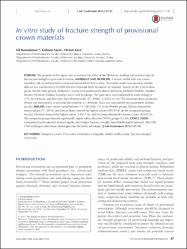| dc.contributor.author | Karaokutan, Işıl | |
| dc.contributor.author | Sayın, Gülsüm | |
| dc.contributor.author | Kara, Özlem | |
| dc.date.accessioned | 10.07.201910:49:13 | |
| dc.date.accessioned | 2019-07-10T19:57:17Z | |
| dc.date.available | 10.07.201910:49:13 | |
| dc.date.available | 2019-07-10T19:57:17Z | |
| dc.date.issued | 2015 | en_US |
| dc.identifier.citation | Karaokutan, I., Sayın, G. ve Kara, Ö. (2015). In vitro study of fracture strength of provisional crown materials. Journal of Advanced Prosthodontics, 7(1), 27-31. https://dx.doi.org/10.4047/jap.2015.7.1.27 | en_US |
| dc.identifier.issn | 2005-7806 | |
| dc.identifier.issn | 2005-7814 | |
| dc.identifier.uri | https://dx.doi.org/10.4047/jap.2015.7.1.27 | |
| dc.identifier.uri | https://hdl.handle.net/20.500.12511/2941 | |
| dc.description | WOS: 000350184300005 | en_US |
| dc.description | PubMed ID: 25722834 | en_US |
| dc.description.abstract | PURPOSE. The purpose of this report was to evaluate the effect of the fabrication method and material type on the fracture strength of provisional crowns. MATERIALS AND METHODS. A master model with one crown (maxillary left second premolar) was manufactured from Cr-Co alloy. The master model was scanned, and the data set was transferred to a CAD/CAM unit (Yenamak D50, Yenadent Ltd, Istanbul, Turkey) for the Cercon Base group. For the other groups, temporary crowns were produced by direct fabrication methods (Imident, Temdent, Structur Premium, Takilon, Systemp c&b II, and Acrytemp). The specimens were subjected to water storage at 37 degrees C for 24 hours, and then they were thermocycled (TC, 5000x, 5-55 degrees C) (n=10). The maximum force at fracture (Fmax) was measured in a universal test machine at 1 mm/min. Data was analyzed by non-parametric statistics (alpha=.05). RESULTS. Fmax values varied between 711.09-1392.1 N. In the PMMA groups, Takilon showed the lowest values (711.09 N), and Cercon Base showed the highest values (959.59 N). In the composite groups, Structur Premium showed the highest values (1392.1. N), and Acrytemp showed the lowest values (910.05 N). The composite groups showed significantly higher values than the PMMA groups (P=.01). CONCLUSION. Composite-based materials showed significantly higher fracture strengths than PMMA-based materials. The CAD-CAM technique offers more advantages than the direct technique. | en_US |
| dc.language.iso | eng | en_US |
| dc.publisher | Korean Academy of Prosthodontic | en_US |
| dc.rights | info:eu-repo/semantics/openAccess | en_US |
| dc.rights | Attribution-NonCommercial 3.0 | * |
| dc.rights.uri | https://creativecommons.org/licenses/by-nc/3.0/ | * |
| dc.subject | Temporary Crown | en_US |
| dc.subject | Provisional Restoration | en_US |
| dc.subject | Composite | en_US |
| dc.subject | Methyl Methacrylate | en_US |
| dc.subject | Fracture Strength, CAD-CAM | en_US |
| dc.title | In vitro study of fracture strength of provisional crown materials | en_US |
| dc.type | article | en_US |
| dc.relation.ispartof | Journal of Advanced Prosthodontics | en_US |
| dc.department | İstanbul Medipol Üniversitesi, Diş Hekimliği Fakültesi, Protetik Diş Tedavisi Ana Bilim Dalı | en_US |
| dc.authorid | 0000-0001-8833-5259 | en_US |
| dc.identifier.volume | 7 | en_US |
| dc.identifier.issue | 1 | en_US |
| dc.identifier.startpage | 27 | en_US |
| dc.identifier.endpage | 31 | en_US |
| dc.relation.publicationcategory | Makale - Uluslararası Hakemli Dergi - Kurum Öğretim Elemanı | en_US |
| dc.identifier.doi | 10.4047/jap.2015.7.1.27 | en_US |
| dc.identifier.wosquality | Q3 | en_US |
| dc.identifier.scopusquality | Q2 | en_US |



















